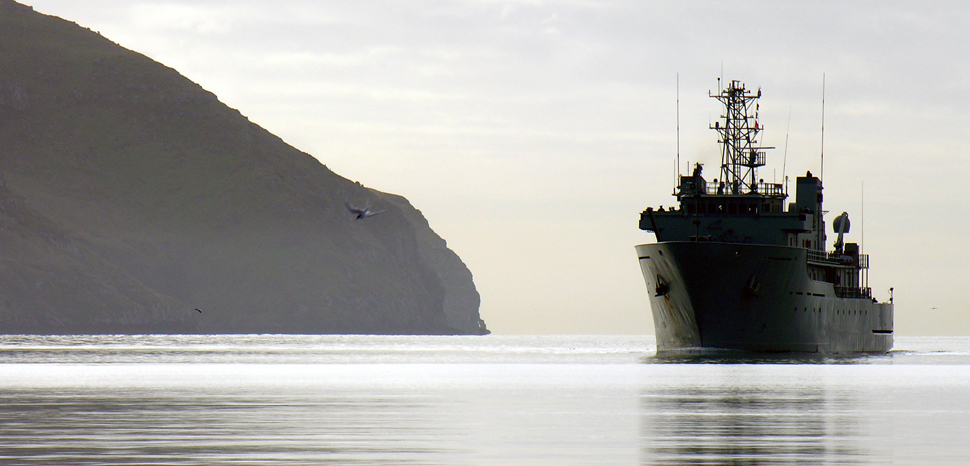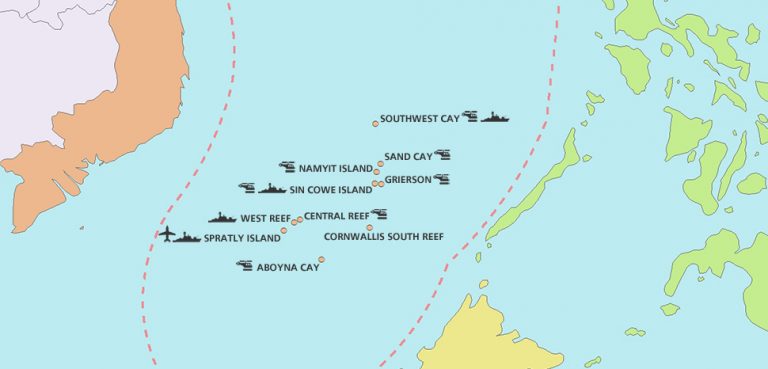According to the classical geopolitical thinking of Sir Halford Mackinder, New Zealand is located in what is called the ‘outer crescent,’ a peripheral zone located very far from the ‘heartland’ (the core the Eurasian landmass). Correspondingly, the vast distance that separates the various territories found in such an insular position from the world’s center of geopolitical gravity means they can only be reached, controlled and/or conquered through formidable sea power projection capabilities.
In fact, in the grand scheme of things, human presence in New Zealand is fairly recent. The Maori people – the island’s original inhabitants– arrived there nearly a millennium ago. The first Europeans did so centuries later and, in the 19th century – during the zenith of Great Britain as the first truly global maritime empire – it became an English settler colony.
Actually, it was (and still is) arguably the remotest Commonwealth realm and, ever since, the country’s economic vitality – a matter of national security – has relied on access to international markets for both imports and exports, something only blue-water navies can effectively guarantee. This explains the country’s historically close geopolitical alignment with both London and Washington. There are of course cultural, social, and linguistic common denominators that also enable intimate ties with the mightiest countries of the Anglosphere.
Moreover, the country’s distant location means it has been well-shielded from the direct fallout of the major military conflicts that haven place throughout the so called ‘rimland’ (Eastern Europe, the Balkans, the Levant, the Persian Gulf, Central Asia and Southeast Asia). However, it lacks the critical mass to influence the course of global affairs in a decisive way. According to data provided by both the CIA World Factbook and the International Monetary Fund:
- New Zealand’s territory covers almost 265,000 square kilometers, which means its extension is smaller than that of Italy.
- Its population (4.5 million people) is comparable to that of countries like Costa Rica (4.9 million) or Ireland (5 million) or, for that matter, US states like Louisiana (4.6 million) or Kentucky (4.4 million).
- The Australasian nation’s GDP (210 billion USD) makes it the world’s 51st largest economy, behind Singapore (372 billion USD), Chile (295 billion USD), and Portugal (239 billion USD).
On the other hand, New Zealand is a prosperous country with high living standards, thanks to its relatively secure location, optimal weather conditions that favor agricultural production and the access to international trade enabled by the island nation’s natural harbors. Its GDP per capita (39,000 USD) is higher than those of European countries like Spain (38,400) and Italy (38,200). To a certain extent, this explains why Wellington has adopted a position of ‘benign neglect’ when it comes to geopolitical affairs. After all, there is no need to get actively involved in such complex –and sometimes even dangerous – games when essential needs are reasonably well-covered.
Another factor that explains New Zealand’s relative isolation is of course its geographical position. Its closest neighbor – Australia – is not exactly contiguous. In fact, a distance of slightly more than 1,300 miles separates Auckland (the most populated metropolis in New Zealand) from Sydney (the very core of the Australian heartland). In contrast, the Channel Tunnel that links the UK with France has a length of only 31 miles.
However, New Zealand’s geostrategic environment is changing due to a combination of ongoing phenomena like rising military tensions in East Asia, the increasing global geoeconomic struggle between the US and China, regional territorial disputes, evolving geopolitical alignments in the Pacific Basin, the growing profile of India as a geopolitical player, Japan’s strategic anxieties, and the wave of technological disruption unleashed by the Fourth Industrial Revolution, amongst others. Plus, as a result of Brexit as a process that is redefining transatlantic relations, the UK and the US might forge even closer ties in several fields, something which entails implications for New Zealand’s national interests. In short, a threshold of transition is in the horizon.
Therefore, Wellington cannot afford to ignore these realities, which present both dangerous challenges and valuable opportunities. Even though New Zealand’s national power is not enough to alter the outcome in any meaningful way, it has to find a way to adapt, especially if it does not want to eventually find itself relegated to a disadvantageous position.
After all, New Zealand has protected its fiercely independent streak and preserved its unique identity, even when facing the might of stronger nations. For instance, it declined to join Australia in the late 19th century, it invaded German Samoa – a German protectorate in the South Pacific – when WW1 broke out and it has banned the presence of ships carrying nuclear weapons in both its ports and territorial waters. Needless to say, the latter – although militarily inconsequential in the grand scheme of things – was an outspoken political and diplomatic statement of national sovereignty vis-à-vis the US.
Right now, NZ can harness changing circumstances in a favorable manner. For this purpose, it must be borne in mind that national states behave a lot like living organisms. If they do not adapt to their surroundings effectively, they well be left in a perilous situation. If inertia prevails, then New Zealand might eventually become a food supplier, a satellite of external powers, or even a contested geopolitical battlefield.
There is a growing sense of situational awareness about the ramifications derived from the aforementioned structural shifts, but Wellington still has not formulated a comprehensive grand strategy to navigate through these uncharted waters. If New Zealand wants to be the master of its own fate, then its intended destination must also be clear.
Hence, in order to envisage what a sound grand strategy for NZ might look like in the following decades, the experience of countries like Switzerland, Israel, and South Korea can be instructive. They have all managed to thrive and prosper as sovereign nations, despite being small states located in dangerous neighborhoods. In order to craft an assertive policy of multidimensional proactive engagement, the following courses of action will have to be considered.
Upgrading New Zealand’s economic profile
Owing to its geographical circumstances, NZ is a naturally competitive producer and exporter of agricultural goods like wine, fruit, meat, cereals, honey, and dairy products, all of which are demanded by the consuming markets in the Asia-Pacific region. In fact, three of New Zealand’s top four trade partners – China, Australia and Japan – are located there.
Moreover, Wellington is negotiating deals to diversify its external trade, through both bilateral and multilateral frameworks. In this pursuit, approaching India, Japan, the ASEAN bloc and the Latin American countries which belong to the Pacific Alliance (Colombia, Chile, Mexico and Peru) can be instrumental. This is necessary in order to avoid a disproportionate degree of economic overdependence, a dangerous condition in times of geopolitical turmoil.
Furthermore, New Zealand has managed to modernize its economy. For instance, it has become a referent when it comes to renewable energy, a priority in terms of national security. Nevertheless, the country needs to be well-prepared for its participation in the leading sectors of the so-called Fourth Industrial Revolution. This does not mean it has to forget about its primary economic activities. As the cases of Switzerland and Israel illustrate, a prosperous agricultural dynamism can coexist with the development of high-tech productive sectors. Besides, another enlightening example is South Korea, a state that, in a matter of decades – during the height of the Cold War no less – went from being a backwater to a world-class industrial powerhouse.
This transition requires measures like 1) the implementation of industrial policies designed to foster new comparative advantages; 2) the encouragement of start-up companies; 3) a strong support for research and development projects; 4) an increasing investment of resources in higher education, particularly in academic disciplines related to STEM; 5) the retention and attraction of competitive human capital; and 6) the establishment of long-term public-private partnerships. It is essential to highlight that, in the era of ‘mindfacturing’, knowledge is a critical ingredient. Therefore, in these processes, New Zealand’s prestigious universities will have a role to play.
Based on its remote geographic position, one of the key sectors that can be developed in New Zealand is aerospace, whose strategic importance derives from its military, commercial, and scientific applications. In fact, New Zealand has already entered the space race thanks to the recent construction – in the Mahia Peninsula – of the facility known as ‘Launch Complex 1,’ a spaceport operated by the US-NZ company Rocket Lab, which offers private spaceflights. In the near future, New Zealand’s natural advantage will constitute an opportunity to open more sites like this and to launch its own space program.
On the other hand, New Zealand’s potential when it comes to untapped oil and gas resources needs to be explored. Hydrocarbons are more than commodities that can be bought and sold for profit. Above all, they still represent strategic geoeconomic assets whose control entails power.
Promoting New Zealand as a financial hub
As an open economy, the natural ability of New Zealand to participate in international trade and its maritime orientation entail the potential to become an attractive regional financial platform, especially as the Pacific Basin is becoming the world’s center of geoeconomic gravity. Moreover, its legislation favors the development of offshore finance and – thanks to its British heritage – it also offers rule of law and respect for the sanctity of private property, all of which are conditions that encourage financial dynamism. Besides, New Zealand’s national character can be described as cosmopolitan. Another factor whose contribution can be helpful is the country’s openness to fintech innovations, including blockchain.
Furthermore, NZ is mostly safe from hostile military actions and, as a country that belongs to the Commonwealth, it has access to Anglo-American financial circuits. Nevertheless, it can also forge close ties to emerging Asian financial and monetary systems. For instance, New Zealand has joined the Asian Infrastructure Investment Bank (AIIB), a multilateral financial framework headed by China, a move that is strategically pertinent. After all, it is profitable to make business with the world’s second-largest economy through projects that foster continental interconnectedness.
However, both possibilities are not mutually exclusive and Wellington could even one day act as a broker whose credibility is respected by all relevant players, regardless of their geopolitical alignments. Reaching this balance can be tricky, but it is a must when one cannot afford to alienate competing sides. For this pursuit, the example set by the role Switzerland has played in Europe –even in times of systemic turmoil – is instructive. It is a small country (whose geopolitical reality shields it from the external aggression of surrounding powers) that has harnessed its conditions to preserve its independence, protect its monetary sovereignty, nourish its distinctive identity and strengthen its national power in diplomacy and finance. As such, it can negotiate with countries whose agendas are dissimilar.
Likewise, the New Zealand dollar (NZD) is regarded as a hard currency. According to the SWIFT network, the NZD is the world’s 18th most-used currency, judging by its proportional share of global payments. This puts it ahead the Mexican Peso and its Chilean namesake, both issued by countries whose economies are considerably larger than that of New Zealand.
Last but not least, other indicators of financial development (like depth of financial markets or access to financial institutions) reflect New Zealand’s competitive potential in this respect. For example, according to a study published by the IMF back in 2016, when it comes measuring the efficiency of financial institutions in several jurisdictions from all over the world, NZ is in the second best position, ahead of Japan, Australia, Singapore, Macau, Luxemburg, and even Switzerland itself (all of which are seen as prestigious in the realm of international finance).
The quest for Lebensraum in Antarctica
The Arctic is becoming a contested geopolitical battleground due to the fact several great powers are struggling to reach a dominant position there. In fact, it is foreseeable that something similar will unfold in Antarctica as its ice sheets melt. The resulting improvement of weather conditions there will be a structural game-changer that could facilitate the development of infrastructure and logistical chains that will enable a more permanent human presence in close proximity to the South Pole, which entails the potential to undertake military, scientific and economic activities. Hence, New Zealand is strategically positioned to access the frozen continent, the only major landmass on Earth still uninhabited by humans.
It is merely a matter of time before the Antarctic Treaty is rendered obsolete by the geopolitical race to controls its resources. Actually, it is believed Antarctica’s promising potential could offer vast deposits of metals like gold, silver, copper, iron, titanium, nickel, manganese, cobalt, zinc and uranium, along with hydrocarbons. Hence, the prospect of mining operations there is likely to be conceivable in the near future. Accordingly, the active presence of great powers in Antarctic territory will be a fact on the ground sooner or later.
This context provides a valuable window of opportunity for Wellington to seek Lebensraum in Antarctica. It must be borne in mind that, thanks to its presence in Antarctic territory through the Ross Dependency, New Zealand is a Polar claimant, but its foothold there is relatively modest. The Scott base – a research facility operated by the state agency known as ‘Antarctica New Zealand’ – is a visible sign of Wellington’s national interest in the southernmost corner of the world. However, the protection of those interests requires a stronger presence. After all, exploration and extractive activities –along with their defense – demand a solid expeditionary reach.
Such drive would also represent an incentive for the quantitative and qualitative improvement of New Zealand’s power projection capabilities, especially when it comes to both sea and air power. The task goes beyond deterring illegal fishing. Actually, an army that is suitable for peacekeeping tasks, disaster relief, and limited deployments in support of military allies in specific operational theatres – like Vietnam, the Falklands, Afghanistan and Iraq – can be regarded as already in-place; but that alone will not suffice. A more robust defense capability will be needed.
Of course, strong collaborative partnerships would be instrumental to achieve this. Hence, Wellington needs to harness its preferential access to US military hardware but it can also resort to other countries – like Israel – whose military-industrial complexes manufacture state-of-the-art weaponry. Moreover, NZ would have to formulate an operational doctrine suitable for mobilizations in circumpolar regions. For this endeavor, the expertise of countries like Norway, Chile, and Canada could be more than helpful. Likewise, the fact that Australia – New Zealand’s closest ally – is also interested in Antarctica represents a formidable force multiplier.
Additionally, the implementation of this plan would strengthen national morale by promoting the idea of New Zealand can act as an assertive South Pacific regional power whose interests should not be disregarded by other relevant stakeholders.
Hedging geopolitical bets
For several reasons – including historical, cultural, and linguistic ties – New Zealand has been consistently allied with the Anglosphere. Its troops fought in the Boer War, WW1 (including the Gallipoli campaign), WW2, and conflicts that took place during the Cold War on the side of Atlanticist powers. It is also a NATO extra-regional partner (along with countries like Australia, Colombia, Japan and South Korea, amongst others). Moreover, New Zealand is a full member of the Five Eyes system, an intelligence-sharing alliance that also includes the US, the UK, Canada, and Australia.
Nonetheless, Wellington is not aligned with the Anglosphere only because of a shared heritage or merely out of nostalgia. There are more pragmatic considerations at play. Since its lifelines depend on freedom of navigation, its geopolitical allegiance ultimately lies with the maritime power able to defend open sea lanes. That role was once played by Great Britain and nowadays the United States – the world’s leading sea power – is responsible for providing that service.
Likewise, New Zealand’s location represents a formidable defensive position. In general, Australasia is mostly safe from hostile military mobilizations and Australia is a neighbor that can be both a strategic partner and also a valuable buffer state that provides protection from external threats. However, the prospect of a Japanese invasion during WW2 was regarded as a plausible scenario. Actually, the conquest or the subjugation of both Australia and New Zealand were considered as part of Imperial Japan’s ambitious geostrategic plan (the so-called ‘Greater Asia Co-Prosperity Sphere’). Plus, it must be borne in mind that powerful geopolitical forces can flow through conduits like energy, trade, cyberspace, finance, demography and even ‘soft power.’ There are many ways to control countries aside from kinetic military actions.
On the other hand, the favorable externalities that New Zealand has enjoyed for generations must not be taken for granted, especially now that the international liberal order that prevailed for several decades after WW2 is withering. For instance, although China is certainly an emerging power, it still lacks a powerful navy, yet Beijing can potentially become a far-reaching sea power in the not-so-distant future.
Accordingly, from Wellington’s perspective, it makes sense to be pragmatic toward China. The best course of action would be to avoid either passive accommodation or openly confrontational attitudes. In fact, in this context, Wellington needs to minimize the prospect of being harshly dragged by an increasingly intense vortex of geostrategic competition that could end up swallowing unprepared nations.
Likewise, New Zealand cannot afford to defy the US. After all, the American navy is still the guarantor of global maritime security. Moreover, if Wellington distances itself too much from Washington, the case of Australian Prime Minister Gough Whitlam – presumably removed from office as a result of the covert efforts undertaken by both the CIA and the MI6 – must be borne in mind as a powerful example that such move could be reckless, at least for the time being.
Hence, New Zealand must find a way to navigate through the changing balance of power in order to handle the underlying tension between its economic interests when it comes to bilateral trade with Asia and its close geopolitical collaboration with the US and its maritime allies. NZ does not have to take sides, but a sense of strategic balance must be found. This is a must for national states facing potentially overpowering asymmetric challenges.
The simultaneous formal membership of NZ in both Atlanticist structures and the AIIB (which can be understood as a financial vector of China’s global geopolitical agenda) is a sign that New Zealand’s increasing sense of strategic clarity about the fact that protecting its own national security entails the need to acquire leverage.
Furthermore, there may be new opportunities ahead. For example, once Britain disengages itself from the European Union, there will be a powerful incentive for London to seek closer ties to both the United States and members of the Commonwealth like Canada, Australia, and New Zealand. This could lead to the creation of a trade bloc amongst the most prominent countries of the Anglosphere.
However, thinking that Wellington will eventually have to side with either Washington or Beijing as a junior partner is a false dilemma, especially considering it has cards to play in order to strengthen its position. For instance, Israel is a firm US ally when it comes to diplomacy, geopolitics, intelligence and military affairs but – as an independent state that pursues its own national interests in the long run – it has also invested a great deal of effort and resources in the development of a constructive relation with both Russia and China, in case Jerusalem eventually needs the support of the Eurasian behemoths one day.
A way for New Zealand to enhance its geopolitical standing is to court Japan and India. Both countries are regional powers that are worried about the prospect of Chinese regional hegemony. However, both Delhi and Tokyo are aware they cannot rely 100% on US support. Thus, they have to fortify their national power – including its military capabilities – as autonomous stakeholders whose interests cannot be overlooked by other heavyweight players. That makes them ideal partners for an assertive and confident New Zealand, one that’s able to handle the strong gravitational pull of foreign powers.
Conclusion
A major turning point is coming for New Zealand and the country will be exposed to systemic geopolitical drivers beyond its control. If Wellington does not want its fate to be decided by others – at the expense of its own national interests – then the country will have to readjust its long-term grand strategy in order to avoid existential risks and use opportunities to advance its agenda.
This requires some counterintuitive thinking in order to find feasible ways to strengthen the country’s national power in several fields, including geopolitics, trade, economics, finance, diplomacy, technology, and defense. The key imperative is that New Zealand needs to reach a convenient position that is suitable for what is to come. Hence, a conceptual notion of multidimensional proactive engagement can represent an appropriate strategic compass.




